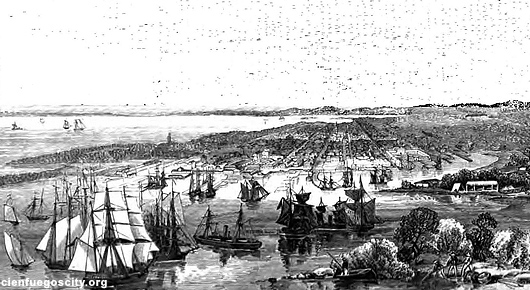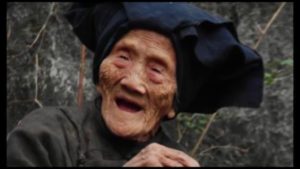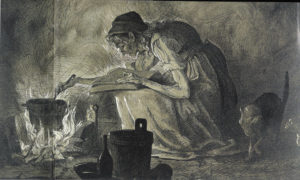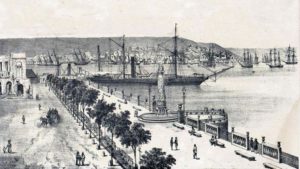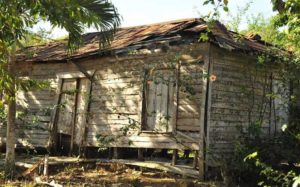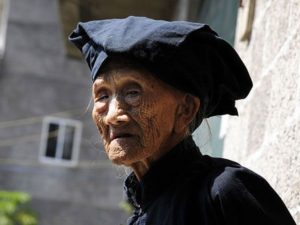An old saying goes that “little town, big hell”. And it seems that this maxim is another wisdom of popular wisdom.
There are people who, in the absence of more edifying work, turn their tongue into a whip with which to pull the strips of their skin from their neighbors … In a hamlet, where nothing ever happens, there is no more help than to go nose- foreign stock.
Yes, the murmuring can become an entire village sport.
The Town of Cienfuegos, Cuba is born.
It was still young in the 19th century -1819- when a group of French immigrants from Bordeaux and Louisiana founded a town near the most beautiful bay of Cuba, the one the aborigines called Jagua.
The first name of the settlement is Colonia Fernandina. (It is not necessary to clarify it: it is another episode of guataquería or chicharronería, that in both ways we denominate the Cubans to the flattery. Because-you see what a coincidence- in those moments in Spain reigns Fernando VII, the one that had face of horse and heart of hyena, perhaps the most fatal of the Iberian monarchs).
Nevertheless, after the own Fernando from Aranjuez dictates – the 20 of May of 1829 – that it is granted to the population the title of town, with the name of Cienfuegos. The king states textually that he does this to perpetuate in the same colony the dignified surname of the Captain General who was Don Jose Cienfuegos, already deceased, author and protector of such a useful establishment.
It should be added that the head of the settlement, then Lieutenant Colonel Bordelés Louis Lorenzo de Clouet Piette (Bordeaux, 1766-Madrid, 1848), was a lord of gallows and knife. It maintained a strong vigilance over the neighbors, which even reached the thoughts of those who lived there.
Ah, but perhaps the worst of the ills that afflicted the incipient population was that, as is often the case in every hamlet, the murmurers abounded more than the bad grass.
THE STORY BEGINS.
It is to imagine the stir that formed in the village when a new face appeared there. And what a face, my God.
It was a toothless old woman, with an earthy face and a hooked nose. Of course, from there to ensure that it was a witch sent by the very same Enemy Bad, there was only one step.
“Na Belen,” the newcomer was called, “without much of the talk, settled down in the estate of Las Calabazas, and for that reason acquired the name of” La Vieja de Las Calabazas. ”
The sensible people-fortunately always there-never tired of repeating that there was nothing evil about the old woman, who was an unhappy woman who had come from the village of Yaguaramas, accompanied by a res, her only earthly possession.
The pretended witch earned her life honorably, practicing the office of washerwoman. But he also possessed a knowledge of vegetable medicine – green, we would say today -, which ensured the animosity of Dr. Mongenié and Vallejo, and the apothecary Lanier, who saw in the old woman a competitor who would endanger the stability of her clientele .
As will be understood, only an excuse was lacking for an offensive against the laundress-herbalist. And this soon appeared.
Tertiary fevers and other fevers, which began with cold manifestations, increased.
Immediately, some murmurer hinted that this was the result of Na Bethlehem’s bad arts. Another said that the Pumpkin Old Woman was poisoning, while a third said it provoked attacks of distress on the children.
Thus, the avalanche of slander grew, and in the end it turned out that Bethlehem was preparing a devilish garment with fat of newborns, thanks to which it rose in the air riding on the proverbial broom.
Not to doubt, even the very physical integrity of the old woman was in danger. And Don Luis de Clouet may have been as much of a despot as he wished, but he had not a foolish or uninformed hair. So the head of the Cienfuegos colony appeared before Na Belen, and perhaps with good words, perhaps with some small gift, convinced her that she should leave those places for the sake of public tranquility and her own health.
Did it end with gossip? No, not much less. The lengüilargos, after the disappearance of the Old one of the Pumpkins, did not give rest to the sinhueso. And there were those who claimed to have seen Bethlehem burst like a rocket, for when she had taken flight on the broom after stealing a child, her mother had conjured her with the sacred names of Jesus, Mary, and Joseph.
It is said that in those days a gossip asked De Clouet for the whereabouts of Na Bethlehem. The respondent, with his typical French accent, gave the following answer:
“Ma’am, La Vieja de las Calabazas is gone, notifying me that she is ready to return to take possession of children whose mothers are not being watched or cared for properly. But I, madame, will not allow her to return, because beforehand I am going to punish exemplarily the mothers who by gossiping fail to fulfill their duties.
And so that lord of gallows and knife gave a masterful lesson of good sense, common sense, and repudiation of gossip.
PUEBLO CHICO, INFIERNO GRANDE: LA HISTORIA DE “ÑA BELÉN, LA VIEJA DE LAS CALABAZAS”.
Dice un viejo refrán que “pueblo chiquito, infierno grande”. Y parece que esta máxima es otro acierto de la sabiduría popular.
Hay gente que, a falta de más edificante labor, transforma la lengua en un látigo con el cual arrancarle las tiras del pellejo al prójimo… En una aldehuela, donde nunca suceda nada, no hay más socorrida ocupación que andar metiendo las narices en ajenas existencias.
Sí, la murmuración puede llegar a constituir todo un deporte pueblerino.
Nace el pueblo de Cienfuegos, Cuba.
Aún era joven el siglo XIX —1819— cuando un grupo de inmigrantes franceses, procedentes de Burdeos y de la Luisiana, fundan una población junto a la más hermosa bahía de Cuba, esa que los aborígenes llamaban Jagua.
El primer nombre del asentamiento es Colonia Fernandina. (No hay que aclararlo: constituye otro episodio de guataquería o chicharronería, que de ambos modos denominamos los cubanos a la adulación. Porque —mire usted qué casualidad— en aquellos momentos en España reina Fernando VII, el que tenía cara de caballo y corazón de hiena, quizás el más funesto de los monarcas ibéricos).
No obstante, después el propio Fernando desde Aranjuez dictamina —el 20 de mayo de 1829— que se conceda a la población el título de villa, con el nombre de Cienfuegos. El rey declara textualmente que lo hace para perpetuar en la misma colonia el digno apellido del Capitán General que fue Don José Cienfuegos, ya difunto, autor y protector de tan útil establecimiento.
Agréguese que el jefe del asentamiento entonces, el teniente coronel bordelés Luis Lorenzo de Clouet Piette (Burdeos, 1766-Madrid, 1848), era todo un señor de horca y cuchillo. Mantenía sobre los vecinos una férrea vigilancia, que llegaba hasta los pensamientos de quienes allí habitaban.
Ah, pero quizás el peor de los males que aquejaban a la incipiente población era que, como suele suceder en toda aldehuela, los murmuradores abundaban más que la yerba mala.
Comienza Nuestra Historia.
Es de imaginar el revuelo que se formó en el pobladito cuando apareció por allí una cara nueva. Y, qué cara, Dios mío.
Se trataba de una vieja desdentada, de faz terrosa y nariz ganchuda. Como es lógico, de ahí a asegurar que se trataba de una bruja enviada por el mismísimo Enemigo Malo, no había más que un paso.
Ña Belén —así se llamaba la recién llegada—, sin hacer mucho ni poco caso de las habladurías, se estableció en la finca de Las Calabazas, y por eso adquirió el nombre de ‘La Vieja de Las Calabazas’.
La gente sensata —que siempre la hay, por fortuna— no se cansaba de repetir que no había nada de maléfico alrededor de la anciana, quien era una infeliz que había llegado del poblado Yaguaramas, acompañada de una res, su única posesión terrenal.
La pretensa bruja se ganaba la vida honradamente, ejerciendo el oficio de lavandera. Pero, además, poseía conocimientos de medicina vegetal —verde, diríamos hoy—, con lo que se aseguró la animadversión de los doctores Mongenié y Vallejo, y del boticario Lanier, quienes vieron en la anciana una competidora que haría peligrar la estabilidad de su clientela.
Como se comprenderá, para emprender una ofensiva contra la lavandera-herbolaria sólo faltaba un pretexto. Y éste no tardó en surgir.
Sucedió que tomaron incremento las fiebres tercianas y otras calenturas, que comenzaban con manifestaciones de frío.
De inmediato, algún murmurador insinuó que aquello era el resultado de las malas artes de Ña Belén. Otro dijo que La Vieja de las Calabazas era envenenadora, mientras que un tercero aseguró que provocaba ataques de alferecía en los niños.
Así, el alud de la maledicencia fue creciendo, y al final resultó que Ña Belén preparaba un unto diabólico con grasa de recién nacidos, gracias al cual se elevaba en el aire cabalgando en la proverbial escoba.
A no dudar, ya hasta la misma integridad física de la anciana estaba en peligro. Y Don Luis de Clouet puede haber sido todo lo déspota que se quiera, pero no tenía ni un pelo de tonto o de desinformado. Por eso, el jefe de la colonia cienfueguera se presentó ante Ña Belén y, quizás con buenas palabras, quizás con alguna pequeña dádiva, la convenció de que debía abandonar aquellos parajes en bien de la tranquilidad pública y de su propia salud.
¿Terminó aquello con el chismorreteo? No, ni mucho menos. Los lengüilargos, tras la desaparición de La Vieja de las Calabazas, no le dieron descanso a la sinhueso. Y hubo quien aseguró haber visto a Ña Belén reventar como un cohete, pues al emprender vuelo en la escoba tras robar un niño, la madre la había conjurado con los sacratísimos nombres de Jesús, María y José.
Se cuenta que por aquellos días una chismosa le preguntó a De Clouet por el paradero de Ña Belén. El interpelado, con su típico acento francés, le dio la siguiente respuesta:
—Señora, La Vieja de las Calabazas se fue, notificándome que está dispuesta a volver para apoderarse de los niños cuyas madres no los vigilan ni cuidan como es debido. Pero yo, señora, no permitiré que regrese, porque antes voy a castigar ejemplarmente a las madres que por andar chismoseando incumplen con sus deberes.
Y así aquel señor de horca y cuchillo dio una lección magistral de sensatez, tino, sentido común y repudio a la chismografía.
Agencies/Flechazos/Argelio Santiesteban/Extractos/ Internet Photos/ Arnoldo Varona/ TheCubanHistory.com
THE CUBAN HISTORY, HOLLYWOOD.




